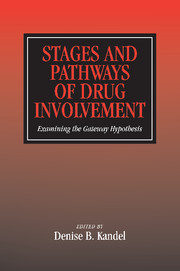Book contents
- Frontmatter
- Contents
- List of Contributors
- Foreword
- Preface
- Part I Overview
- 1 Examining the Gateway Hypothesis: Stages and Pathways of Drug Involvement
- Part II Recent Substantive Findings: What Do We Know About Stages of Drug Use, Risks, and Protective Factors?
- Part III Impact of Prevention Interventions: A Test of the Progression Hypothesis
- Part IV Methodological Issues and Approaches: Advantages and Limitations of Alternate Methods
- Part V Animal Models and Biological Processes: Implications for Drug Progression
- Part VI Conclusion
- Index
1 - Examining the Gateway Hypothesis: Stages and Pathways of Drug Involvement
Published online by Cambridge University Press: 25 July 2009
- Frontmatter
- Contents
- List of Contributors
- Foreword
- Preface
- Part I Overview
- 1 Examining the Gateway Hypothesis: Stages and Pathways of Drug Involvement
- Part II Recent Substantive Findings: What Do We Know About Stages of Drug Use, Risks, and Protective Factors?
- Part III Impact of Prevention Interventions: A Test of the Progression Hypothesis
- Part IV Methodological Issues and Approaches: Advantages and Limitations of Alternate Methods
- Part V Animal Models and Biological Processes: Implications for Drug Progression
- Part VI Conclusion
- Index
Summary
The notion that there are developmental stages and sequences of involvement in drugs was first advanced a quarter of a century ago (Hamburg, Kraemer, & Jahnke, 1975; Kandel, 1975). According to this notion, there is a progressive and hierarchical sequence of stages of drug use that begins with tobacco or alcohol, two classes of drugs that are legal, and proceeds to marijuana, and from marijuana to other illicit drugs, such as cocaine, metamphetamines, and heroin. The basic premise of the developmental stage hypothesis is that involvement in various classes of drugs is not opportunistic but follows definite pathways; an individual who participates in one drug behavior is at risk of progressing to another. The notion of developmental stages in drug behavior does not imply, however, that these stages are either obligatory or universal, nor that all persons must progress through each in turn.
In the early 1980s, the term Gateway drug began to be used to refer to alcohol and cigarettes, the drugs that are used prior to the use of illicit drugs. Soon, the usage was extended to include the use of marijuana as a precursor to the use of other illicit drugs, such as cocaine or heroin, and more rarely even to cocaine as a precursor to heroin. It is not clear how the term Gateway drug originated and I could not locate any relevant literature.
- Type
- Chapter
- Information
- Stages and Pathways of Drug InvolvementExamining the Gateway Hypothesis, pp. 3 - 16Publisher: Cambridge University PressPrint publication year: 2002
- 42
- Cited by



